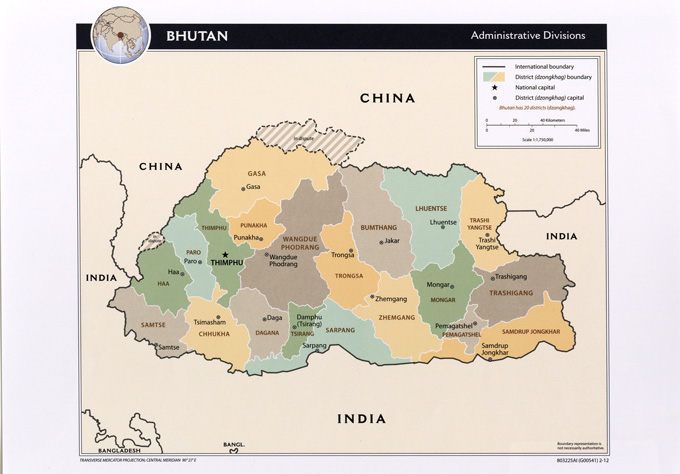Location

Mostly known to the outside world as the last Shangrila and the Land of Happiness, Bhutan is a small landlocked country in the Eastern Himalayas bordered by China in the north and India on the other three sides. With a total land area of 38,394 sq. kms, the landscape is characterized by rugged terrain and steep mountain valleys ranging from 150 meters in the subtropical valleys in the southern foothills, through temperate zone to heights exceeding 7,000 meters in the alpine regions of the mountains.
With over 72% of its land under forest cover, it has one of the richest biodiversities in the world with about 3,281 plant species per 10,000 square kilometers and has been declared as one of the ten global biodiversity ‘hot spots’.The country’s forests of temperate and sub-tropical species are home to many rare species of flora and fauna. An estimated 770 species of birds and over 50 species of rhododendron, along with an astonishing variety of medicinal plants (over 300 species) and orchids are endemic to this region.
Rare animals like the golden langur, takin, and snow leopard are found distributed widely in Bhutan. It is also one of the wintering grounds for the rare and endangered black-necked cranes.
Bhutan has three distinct climatic zones corresponding broadly to the three geographical divisions – hot and humid southern belt, cool temperate central zone, and alpine northern region.
People and Culture
 With a total population of less than 700,000, Bhutan has three major ethnic groups. The ngalops living in the western region, sharchops in the east and the Lhotsampas in the south.
With a total population of less than 700,000, Bhutan has three major ethnic groups. The ngalops living in the western region, sharchops in the east and the Lhotsampas in the south.
More than 70% of the population live in rural areas and are mostly famers engaged in subsistence farming.
Dzongkha, the national language of Bhutan is the mother tongue of the people living in the western region. While about 18 dialects are spoken in Bhutan some of the vernacular languages are under imminent threat of extinction. English, being the medium of instruction in all the schools, is widely spoken.
Most Bhutanese by nature are warm and friendly.
The Bhutanese are, by nature, physically strong and fiercely independent with an open and ready sense of humor. The men wear Gho, a long robe tied around the waist by a fabric belt, or Kera. The main garment of women, Kira, is an ankle length wrap-around dress secured by a belt around the waist, and fastened at the shoulders with silver brooches called Koma.
There is no rigid class system in Bhutan and social and educational opportunities are not affected by rank or birth. Bhutanese women enjoy equal rights with men. Both men and women are free to choose their partners for marriage and both can initiate a divorce.
Bhutan’s traditional culture is alive in its performing arts, such as dance and music, which are an integral part of religious ceremonies. Traditional arts and crafts are still practiced as they were done hundreds of years ago.
Bhutan’s textile tradition has, in recent years, gone international. The distinct technique, color, and style of indigenous Bhutanese weaving are being increasingly appreciated by textile specialists, collectors, and users from many parts of the world.
ARTS & CRAFTS
The Bhutanese civilisation and its core values are reflected in its unique art and architecture. It forms an important element of the national heritage.
Bhutan’s thirteen traditional arts and crafts (Zorig Chusum) is a legacy from the 17th century masters. They include: Woodwork (Shing Zo), Stonework (Dho Zo), Carving (Par Zo), Painting (Lha Zo), Sculpting (Jim Zo), Casting (Lug Zo), Wood Turning (Shag Zo), Blacksmithy (Gar Zo), Ornament Making (Troe Ko), Bamboo Work (Tsha Zo), Paper Making (De Zo), Tailoring and Embroidery (Tshem Zo), and Weaving (Thag Zo).
Economy
Planned economic development took place in Bhutan in the 1960s and within the last five decades, Bhutan has transformed from a rural barter system to a modern market-based economy.
Tourism is one of the major industry contributing to the Bhutanese economy. On an average, the economy is projected to grow at a rate of 8% from 2008-2013. This growth will be fueled by the construction of several large hydropower projects in the country.


